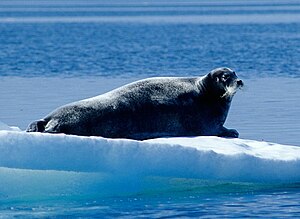Bearded seal
| Bearded seal | ||||||||||||
|---|---|---|---|---|---|---|---|---|---|---|---|---|

Bearded seal |
||||||||||||
| Systematics | ||||||||||||
|
||||||||||||
| Scientific name of the genus | ||||||||||||
| Erignathus | ||||||||||||
| Gill , 1866 | ||||||||||||
| Scientific name of the species | ||||||||||||
| Erignathus barbatus | ||||||||||||
| ( Erxleben , 1777) |
The bearded seal ( Erignathus barbatus ) is the largest Arctic seal and got its name because of its strikingly long white whiskers.
features
The color of the fur is dark gray on the back of male and female bearded seals and a little lighter on the belly. The coat changes between March and August . Protected against the arctic weather conditions during winter by very thick subcutaneous fat , the bearded seal looks quite plump and its head is relatively small. It then weighs up to 360 kilograms, while in the summer months with much less fat tissue it only weighs up to 230 kilograms; the subcutaneous tissue makes up 30 to 40 percent of body weight. Their average length is about two and a half meters. Characteristic are almost rectangular shaped front fins, the annual rings of which indicate the age (maximum age about 30 years).
habitat
The bearded seals live in the circumpolar arctic drift ice areas all year round . They are particularly common in the Bering Sea , but the number of around 300,000 bearded seals living in Canadian waters is not inconsiderable.
Way of life
Bearded seals are usually solitary. They prefer to stay in close proximity to open water, especially on floating pack ice, where crevasses and polynyas offer them escape routes and openings to breathe and polar bears, their natural predators, cannot hunt them. In winter, the bearded seals are generally able to stay under a closed ice cover and draw air through breathing holes they keep open in the ice, but they prefer sea regions with thinner ice that they can break open with headbuttons. Occasionally bearded seals have strayed as far as central European coasts and even northern Spain in winter .
If the animals feel undisturbed, they swim with their heads and backs above the surface of the water; when sleeping they float vertically with their snouts sticking out of the water.
Bearded seals prefer shallower waters as a hunting ground, but they can dive to depths of 220 meters. They eat organisms that live on the seabed and use their whiskers to track them down, such as crustaceans , mussels and snails , but they also prey on smaller fish.
Male bearded seals let out vowel-rich chants underwater, which are not unlike those of the whales and which point to a complex social structure among the animals. These chants reach their climax in April and May, presumably to delimit the territories and to advertise the females. The mating season is in mid-May. The fertilized egg does not implant until two months later, and the gestation period is then eleven months. The young bearded seals are born on the ice in late April to early May. During the suckling period of 12 to 18 days there is a very close bond with the mother, after which the boys who are now able to swim are left to their own devices. The females, which are sexually mature at around six years of age, usually give birth every one to two years.
Bearded seal hunt
An estimated 10,000 bearded seals are killed annually because they are still important to the Eskimos because of their firm yet flexible skin and also because of their meat, which is suitable as food for humans and dogs. The skin used to be used as a reference material for kayaks and qarmaqs ( sod huts) as well as for making ropes and for soling fur boots ("kamit"). The latter are still made from this material today.
Due to its solitary way of life and its fur, which is less valued in the trade, this species of seal was never hunted in large numbers by fur hunters and its population was therefore not endangered.
literature
- Ronald M. Nowak: Walker's Mammals of the World , 6th edition. Johns Hopkins University Press, Baltimore 1999, ISBN 0-8018-5789-9
- Seals of the Northwest Territories . Ed. Department of Resources, Wildlife and Economic Development, Yellowknife (1st edition 1992)
Web links
- Erignathus barbatus in the endangered Red List species the IUCN 2006. Posted by: Seal Specialist Group, 1996. Retrieved on 12 May, 2006.

